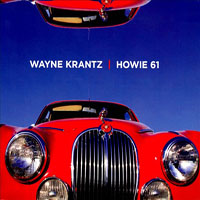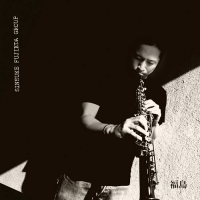Home » Jazz Articles » Extended Analysis » Wayne Krantz: Wayne Krantz: Howie 61
Wayne Krantz: Wayne Krantz: Howie 61
 Wayne Krantz
Wayne KrantzHowie 61
Abstract Logix
2012
He's long been a musician's musician and a guitarist's guitarist—there's a reason Steely Dan's Donald Fagen recruited him for his last solo disc, Morph the Cat (Reprise, 2006), and saxophonists David Binney and Chris Potter called him up for Graylen Epicenter (Mythology, 2011) and Underground (Sunnyside, 2006), respectively. Krantz's instantly recognizable, head-cocking idiosyncracies, combined with his distinctive harmonic language and effortless ability to groove, even at his most oblique, continues to be a lightning rod, with drummer/keyboardist Gary Husband also recruiting him for a track on this year's Dirty & Beautiful Volume 2 (Abstract Logix).
So why hasn't Krantz achieved greater popular acclaim, to go along with the critical acclaim and affirmation in the musical community?
As exhilarating and downright visceral as he can be, Krantz's own skewed sensibilities may have been working against him. A run of recordings for Enja, starting with 1990's Signals and ending with 1998's Long to Be Loose were undeniably fine, but with much of his writing extending past the six and seven-minute range, perhaps it was just too quirky and presented in too indigestible chunks, for a broader audience. Since coming to Abstract Logix with 2009's stunning Krantz Carlock Lefebvre, which documented his working trio, Krantz has made two significant changes—changes that bear even greater fruit on the ultimately more impressive Howie 61.
First, Krantz is singing, and while that will be no surprise to fans of his last record, where he sang (albeit, in most cases, relatively skimpily) on four tracks, all but two of Howie 61's ten tracks are not just vocal tracks, but actual songs—though, true to form, not always possessing conventional song form. If the thought of an artist long considered an instrumentalist has a distinct potential to become cringe-worthy as a singer, there's no fear of that with Krantz, who works with what he's got, and does so with great success. He raps his way through the drily witty title track with the same cadence as his inspiration, Bob Dylan's classic "Highway 61 Revisited," but when he does actually sing melodies, he possesses a voice that may not be classic in the trained sense, but is absolutely perfect for his own acerbic prose, which ranges from musings on the War on Terror ("The Bad Guys") to a few words of appreciation ("I'd Like to Thank My Body").
With Krantz Carlock Lefebvre, the guitarist also began to explore shorter forms, and he continues the trend on Howie 61, where only three songs extend past four minutes: Krantz's instrumental, dub-informed version of Ice Cube's "Check Yo Self" (the album's one cover); the greasy-grooved "Son of a Scientist"; and the semi-anthemic and perfectly titled closer, "How the West Was Left." The rest of the songs are in the two-to-four minute range, but if any of these changes suggest compromise on Krantz's part, nothing could be further from the truth.
Howie 61 is, in fact, the culmination (but, thankfully, not the end) of a longtime desire to put words to his music, a desire that dates back to Long to Be Loose. Krantz's writing remains idiosyncratic and, at times, downright knotty, but in shorter packages there's more potential to appeal to those who may find his lengthier compositions daunting. It's no surprise, based on Krantz's wit and melodic eccentricities, that Fagen used him for Morph, and if the guitarist's solos are restricted to shorter durations here on Howie 61, that may well be a lesson learned from The Dan Man; but knowing how to say plenty in confined spaces is all to Krantz's credit. And if Fagen has always been about pop songs infused with the language of jazz, Krantz comes to songwriting from the other side of the equation, though it's not hard to imagine a song like the up-tempo "The Bad Guys" working its way into the Fagen songbook.
Unlike Krantz Carlock Lefebvre, Howie 61 employs a larger cast, with the same lineup (or, at least, close to) appearing on no more than two tracks. With rhythm sections employing bassists like John Patitucci, Tal Wilkenfeld and James Genus, and drummers like Charley Drayton, Kenny Wollesen, Vinnie Colaiuta and, on one track, Carlock, it's a certainty that Howie 61 will be filled with masterful and get-down-with-your-bad-self grooves. But, at the end of the day—and, perhaps, even more than any of his solo albums to date—the career-defining Howie 61 is unmistakably Krantz's record. His most accessible yet, without sacrificing any of what's made him a musician's musician, Howie 61 signals a directional shift that could (should) garner him the larger audience he deserves, without losing any of those who've been following him all along.
Tracks: Howie 61; The Bad Guys; Check Yo Self; I'm Afraid That I'm Dead; Son of a Scientist; Can't Stand to Rock; I'd Like to Thank My Body; U Strip It; beLls; How the West Was Left.
Personnel: Wayne Krantz: guitars (1-3, 5-10), vocals (1, 2, 4-8, 10), piano (4), ring modulator (9); Henry Hey: piano (1); Owen Biddle: bass (1); Nate Wood: drums (1);John Beasley: piano (2, 5, 6, 8, 10); John Patitucci: bass (2, 8); Charley Drayton: drums (2, 8); James Genus: bass (3); Keith Carlock: drums (3); Yasushi Miura: sonics (4); Tal Wilkenfeld: bass (5, 6); Vinnie Colaiuta: drums (5, 6); Gabriela Anders: vocals (5, 7, 10); Kenny Wollesen: drums (7); David Binney: saxophone (8); Anton Fig: drums (9); Paul Stacey: slide guitar (10); Pino Palladino: bass (10); Jeremy Stacey: drums (10).
Track Listing
Howie 61; The Bad Guys; Check Yo Self; I'm Afraid That I'm Dead; Son of a Scientist; Can't Stand to Rock; I'd Like to Thank My Body; U Strip It; beLls; How the West Was Left.
Personnel
Wayne Krantz
guitar, electricWayne Krantz: guitars (1-3, 5-10), vocals (1, 2, 4-8, 10), piano (4), ring modulator (9); Henry Hey: piano (1); Owen Biddle: bass (1); Nate Wood: drums (1);John Beasley: piano (2, 5, 6, 8, 10); John Patitucci: bass (2, 8); Charlie Drayton: drums (2, 8); James Genus: bass (3); Keith Carlock: drums (3); Yasushi Miura: sonics (4); Tal Wilkenfeld: bass (5, 6); Vinnie Colaiuta: drums (5, 6); Gabriela Anders: vocals (5, 7, 10); Kenny Wollesen: drums (7); David Binney: saxophone (8); Anton Fig: drums (9); Paul Stacey: slide guitar (10); Pino Palladino: bass (10); Jeremy Stacey: drums (10).
Album information
Title: Howie 61 | Year Released: 2012 | Record Label: Abstract Logix
Tags
PREVIOUS / NEXT
Wayne Krantz Concerts
Support All About Jazz
 All About Jazz has been a pillar of jazz since 1995, championing it as an art form and, more importantly, supporting the musicians who make it. Our enduring commitment has made "AAJ" one of the most culturally important websites of its kind, read by hundreds of thousands of fans, musicians and industry figures every month.
All About Jazz has been a pillar of jazz since 1995, championing it as an art form and, more importantly, supporting the musicians who make it. Our enduring commitment has made "AAJ" one of the most culturally important websites of its kind, read by hundreds of thousands of fans, musicians and industry figures every month.


















